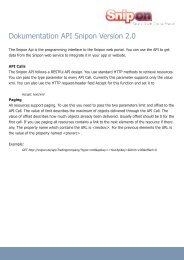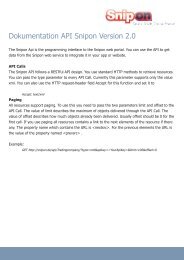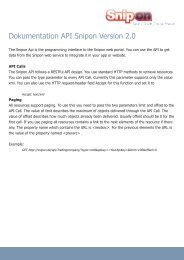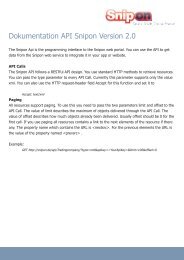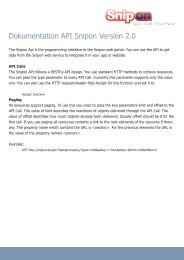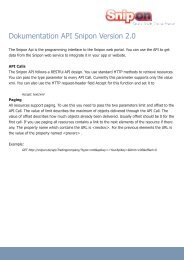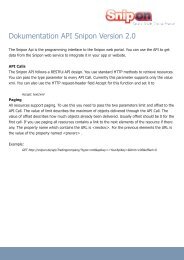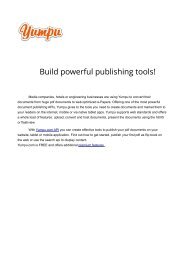test_pdf.pdf
Create successful ePaper yourself
Turn your PDF publications into a flip-book with our unique Google optimized e-Paper software.
ASSESSING<br />
THE RECORD<br />
OF ARMS<br />
CONTROL<br />
way in many countries. There are no rules against acquiring a nuclear fuel capability, no bans on nuclear weapons<br />
research, and no legal provision of nuclear-related cooperation between non-nuclear-weapon states. The CTBT is not<br />
in force, nor is there a fissile material cutoff treaty.<br />
Finally, most of the 13 steps agreed to at the 2000 NPT Review Conference for progress in nuclear disarmament<br />
have not been implemented. This mixed record has led some observers to declare confidently that the NPT regime is<br />
moribund and obsolete. I do not believe it is so bad or too late. But the world urgently needs to work to strengthen its<br />
nuclear disarmament, nonproliferation, and anti-terror mechanisms. Efforts by organizations in civil society, such as<br />
the Arms Control Association, can do much to promote responsible actions to address the many unresolved problems<br />
of the nuclear arms control agenda.<br />
At the outset, I said it is the results that count, so let us revitalize the arms control process, expand our common<br />
search for the practical means to achieve disarmament and nonproliferation goals, and to strengthen the ability to<br />
verify and secure the compliance with nonproliferation and disarmament commitments. For this reason, I salute the<br />
Arms Control Association, not just for its persistence, but for its keen vision of the goals ahead and for its many efforts<br />
to identify and to promote practical measures that are so vitally needed to achieve them.<br />
Let me send my best wishes for your efforts over the years to come. Thank you very much.<br />
MR. STEINBRUNER: Thank you. We do appreciate the encouragement and your presence here.<br />
The final presentation from the panel before we begin discussion will be on the questions of outlawing chemical<br />
and biological weapons. It will be made by Elisa Harris, who is a colleague of mine at the University of Maryland,<br />
well known to all of you as the director of Nonproliferation and Export Controls for the National Security Council<br />
during the Clinton administration, and prior to that a well known scholar of this subject.<br />
Elisa.<br />
ELISA HARRIS: Thank you, John. Good morning, everyone. I’m delighted to participate in this important<br />
conference and to be on this panel with such distinguished colleagues. It’s also terrific to be back at Georgetown,<br />
which is my alma mater. I didn’t know Paul Warnke personally but have been a great admirer of not only his<br />
scholarly work but also of the many things he achieved when he was in public service.<br />
I’ve been asked to assess the record of arms control efforts involving chemical and biological weapons, and so<br />
I’m going to assume, since I’ve been given two weapons systems to discuss, I can take a little bit more time than my<br />
distinguished colleagues.<br />
Efforts to prevent the use of chemical and biological weapons of course go back more than 100 years. There was<br />
the 1899 Hague gas declaration, which outlawed the use of projectiles containing asphyxiating gases, and the 1907<br />
Hague convention, which outlawed poison weapons. It was, though, the 1925 Geneva Protocol which ushered in the<br />
era of modern arms control efforts with respect to CW [chemical weapons] and BW [biological weapons]; it prohibited<br />
the wartime use of poison gas, as well as bacteriological methods of warfare. As many of you know, many<br />
countries, upon ratifying the Geneva Protocol, reserved the right to retaliate in kind should others use chemical or<br />
biological weapons against them, or to use such weapons against nonparties. As a consequence, the Geneva Protocal<br />
over the years came to be seen as a sort of no-first-use agreement.<br />
Half a century later, in 1972, the Biological and Toxin Weapons Convention [BWC] was concluded and it<br />
banned biological and toxin weapons. It was the first arms control agreement to eliminate an entire class of weapons<br />
of mass destruction, but it contained no verification provisions—no means of ensuring that countries were complying<br />
with their obligations. Twenty years later, when the CWC [Chemical Weapons Convention] was concluded, the<br />
situation was very different. It was a milestone for exactly the opposite reason, because it contains the most intrusive<br />
verification provisions ever negotiated in a multilateral agreement.<br />
When Daryl first called me and asked me to speak on this panel about the record of arms control efforts to<br />
outlaw chemical and biological weapons, I realized that there were a number of ways one could approach this<br />
subject. What I would like to do in the time that I have this morning is to focus on three questions: first, whether these<br />
treaties have helped reinforce the norm against the use of chemical and biological weapons; secondly, whether<br />
they’ve helped de-legitimize possession of such weapons; and finally, whether they’ve helped stem the proliferation<br />
of chemical and biological weapons.<br />
Let me begin first with preventing use. I think assessing the record of these treaties in terms of preventing the use<br />
of chemical and biological weapons is probably the most difficult question given the unique circumstances of every<br />
conflict over the past century.<br />
So let’s look at the facts. By any measure, chemical and biological weapons have been used very rarely in armed<br />
conflict since chlorine was used at Ypres in April 1915. There have been only about half a dozen significant uses of<br />
chemical weapons over the past nearly 100 years. There was of course the use of gas by Britain against the Bolsheviks<br />
13<br />
13



